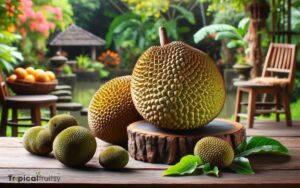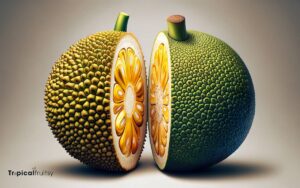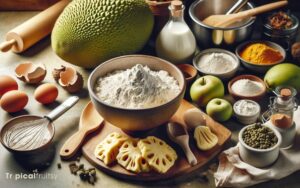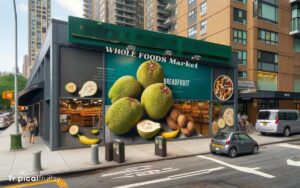What Does Breadfruit Look Like? Explained!
Breadfruit is a tropical fruit with a green, bumpy exterior. It’s similar in size and shape to a grapefruit or small cantaloupe and can range from spherical to oblong.
When cut open, the inside reveals a creamy, white or pale yellow flesh that’s starchy and fibrous with a central core and seeds in some varieties.
Breadfruit is a staple food in many tropical regions, recognized by its distinctive appearance:
Breadfruit not only has a unique appearance but is also packed with nutrients, including carbohydrates, fiber, and vitamins.
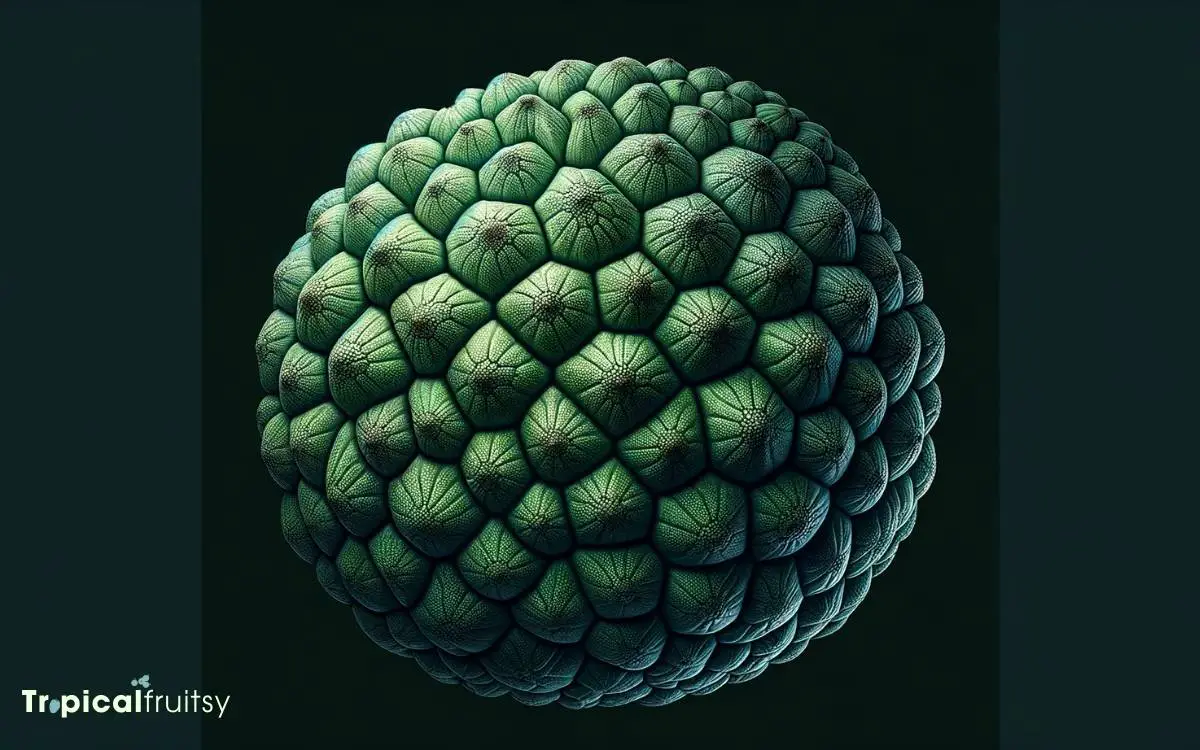
Key Takeaway
Identifying Breadfruit Trees
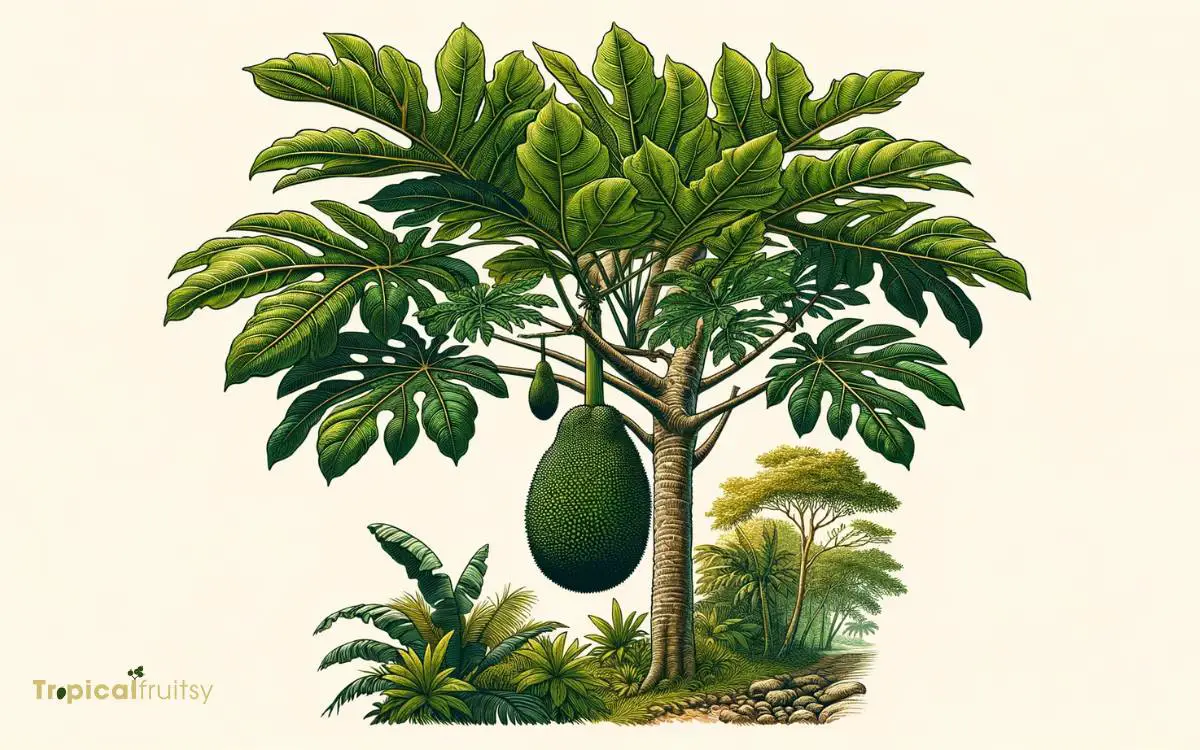
The breadfruit tree, scientifically known as Artocarpus altilis, is a tropical perennial that is easily identifiable by its distinctive foliage and fruit-bearing habits. Endemic to the South Pacific and the Malay Archipelago, it flourishes in an equatorial climate.
The tree can grow to a height of 26 meters, but more commonly reaches around 15 to 18 meters. Its leaves are large, deeply cut, and lobed, often measuring 30cm to 90cm long.
The plant’s reproductive strategy is notable, with its syncarpous fruit, a complex structure formed from the fusion of multiple ovaries.
The fruit itself is typically round, segmented, and has a green to yellowish skin when mature, with a starchy, fibrous interior rich in complex carbohydrates.
Breadfruit Size Range
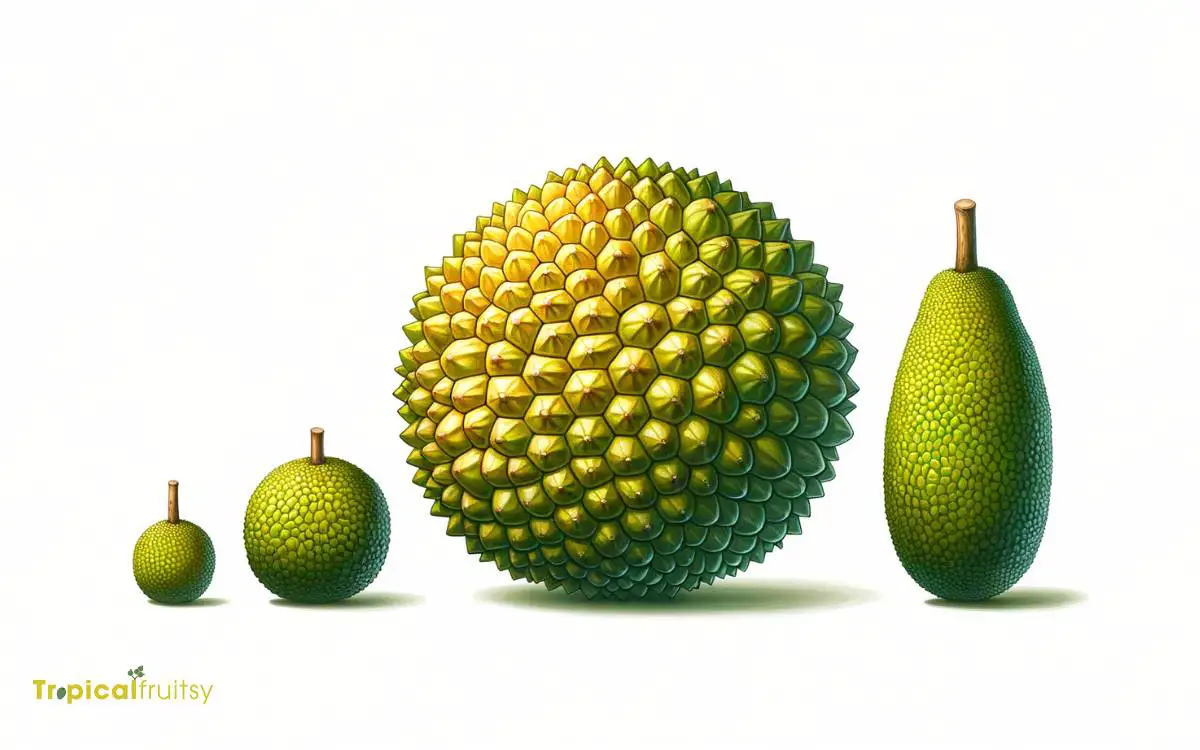
The breadfruit exhibits significant variability in size, which can be analytically compared to familiar fruits for a more precise understanding.
Specimens range from the dimensions of a small melon to those comparable to a large grapefruit, indicating a spectrum of potential sizes.
Additionally, the weight and shape of the breadfruit are subject to variation, factors that are contingent upon specific cultivar characteristics and growing conditions.
Small Melon-Sized
While breadfruit typically varies in size, the smaller specimens are comparable in dimension to a small melon, generally ranging from 10 to 30 centimeters in diameter.
This size categorization is critical when considering the breadth of the Artocarpus altilis species and its morphological characteristics.
The smaller breadfruits, despite their reduced stature, exhibit the same botanical features as their larger counterparts, including a green, textured exterior that may possess hexagonal markings reflective of its composite fruit structure, known as a syncarp.
Scientific examination reveals that the size does not significantly influence the nutritional composition, with all sizes of breadfruit offering a rich source of complex carbohydrates, dietary fiber, and essential vitamins.
Thus, these diminutive versions are equally valuable in culinary and nutritional contexts.
Large Grapefruit Comparison
Many breadfruit specimens are roughly the size of a large grapefruit, expanding the species’ size spectrum to include fruits with diameters typically between 15 and 45 centimeters.
This dimensional range suggests substantial variability within the species, likely attributable to genetic diversity, environmental factors, and cultivation practices.
Breadfruit’s size at maturity is an important phenotypic characteristic, influenced by the interplay of genotype with local soil fertility, precipitation patterns, and sunlight exposure.
Researchers have observed that breadfruit trees grown in optimal climatic conditions and with adequate agronomic care tend to produce larger fruits.
This correlation underscores the significance of environmental inputs on the phenotypic expression of size in breadfruit.
Consequently, understanding the conditions that favor larger fruit development is critical for cultivators seeking to maximize yield and fruit quality.
Variable Weight, Shape
Diversity in breadfruit morphology results in a wide spectrum of weights and shapes, with some fruits exhibiting spherical, oval, or oblong forms.
This phenotypic variability is a product of genetic diversity and environmental factors influencing growth.
Breadfruits can vary greatly in mass, with some weighing as little as 500 grams and others exceeding 5 kilograms. Their dimensions are similarly varied, spanning from 10 to 30 centimeters in diameter.
The size range is a crucial consideration for agricultural practices and marketability, affecting both yield estimates and consumer preferences.
Analyzing this variability is essential for optimizing cultivation techniques and improving crop resilience.
The Skin’s Unique Texture
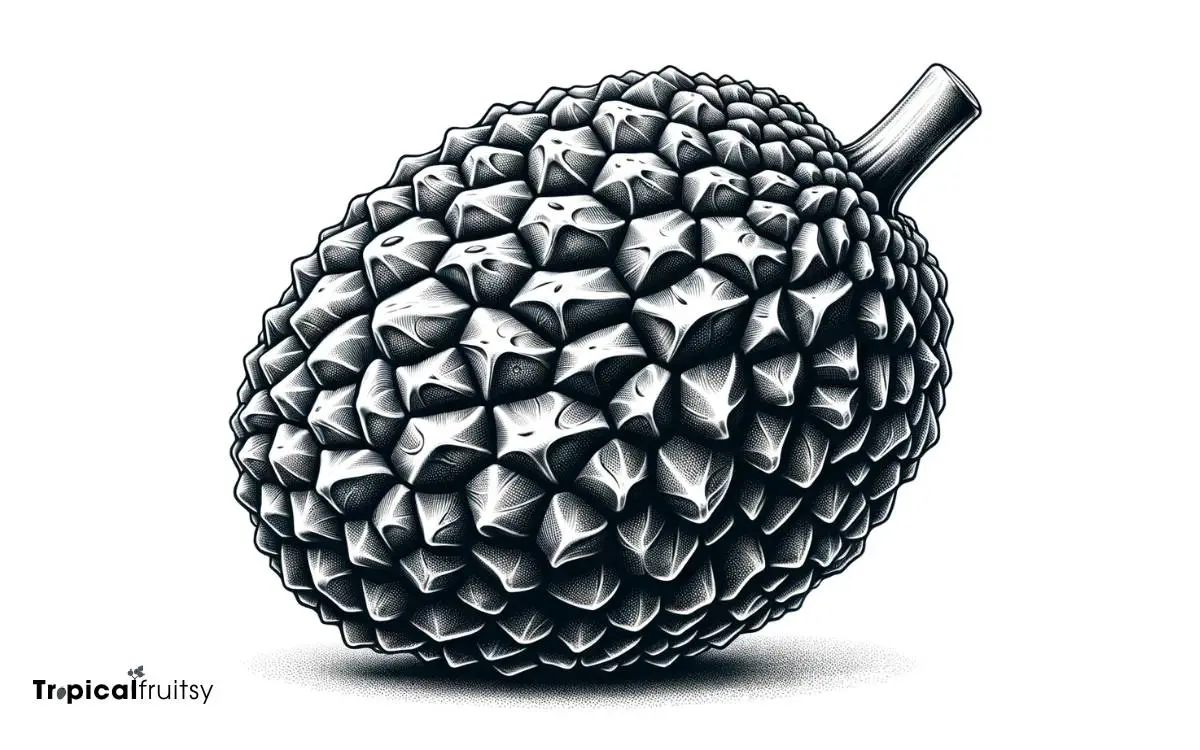
The skin of breadfruit is distinctively textured, often described as having a pattern of diamond-shaped facets that are both tactile and visually unique.
This surface morphology is not merely aesthetic; it plays a role in the fruit’s interaction with its environment.
The geometric patterning can enhance the structural integrity of the fruit, distributing stress and possibly aiding in growth by allowing for subtle expansions.
Furthermore, the skin’s texture may be an evolutionary adaptation to discourage predation, as the irregular surface can be less palatable or more difficult for certain animals to grasp.
Scientific analysis of the skin’s texture could provide insights into its functional advantages and the evolutionary pressures that shaped it.
As breadfruit matures, this textured surface undergoes a transformation indicative of ripening, marked by notable color changes.
Color Changes During Ripening
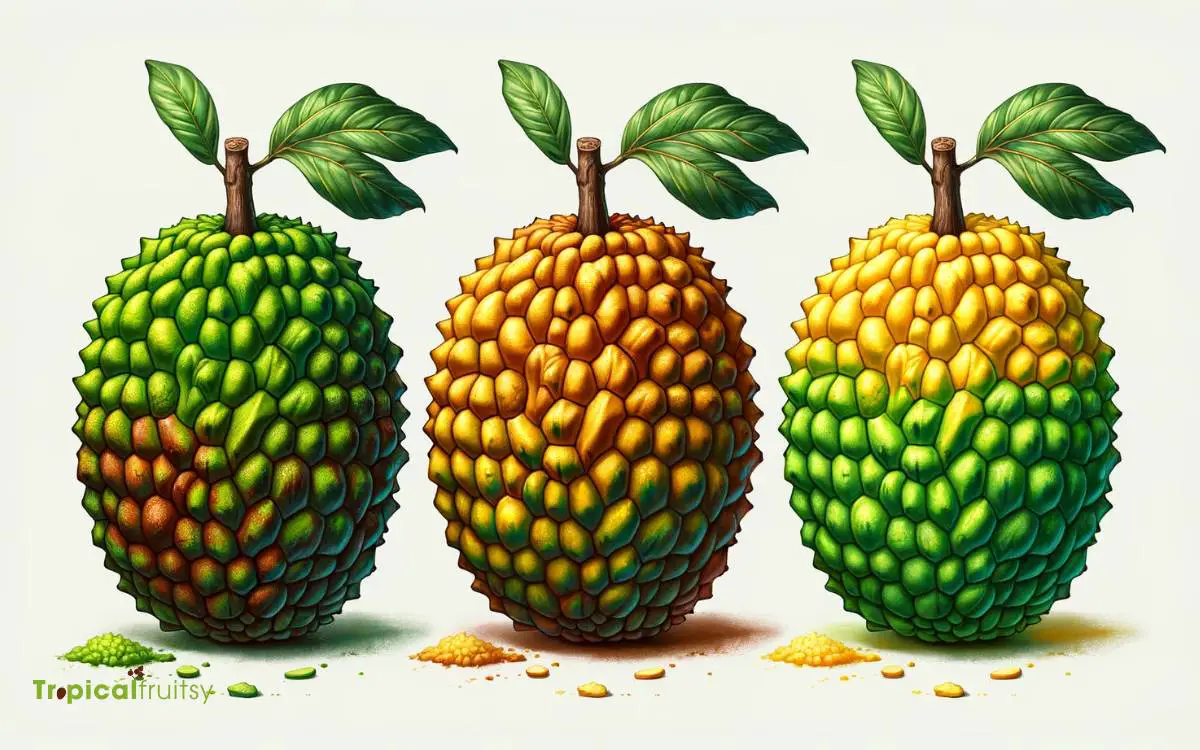
Observing the ripening process of breadfruit reveals a dynamic shift in coloration, transitioning from a green to yellowish hue that signals maturity and readiness for consumption.
This change is indicative of complex biochemical processes occurring within the fruit, reflecting alterations in chlorophyll concentration and the emergence of carotenoid pigments.
- Initial Green Phase: High chlorophyll content gives unripe breadfruit its green color.
- Chlorophyll Degradation: As ripening progresses, chlorophyll breaks down, diminishing the green intensity.
- Carotenoid Increase: Concurrently, carotenoids accumulate, imparting a yellowish tint to the flesh.
- Visual Maturity Indicator: The color transition serves as a visual cue for optimal harvest time.
- Environmental Influence: External factors such as sunlight exposure can affect the rate and uniformity of color change.
Understanding these color variations provides critical insight into the ripening stages, ensuring breadfruit is harvested at its peak for nutritional and culinary purposes.
Inside the Breadfruit
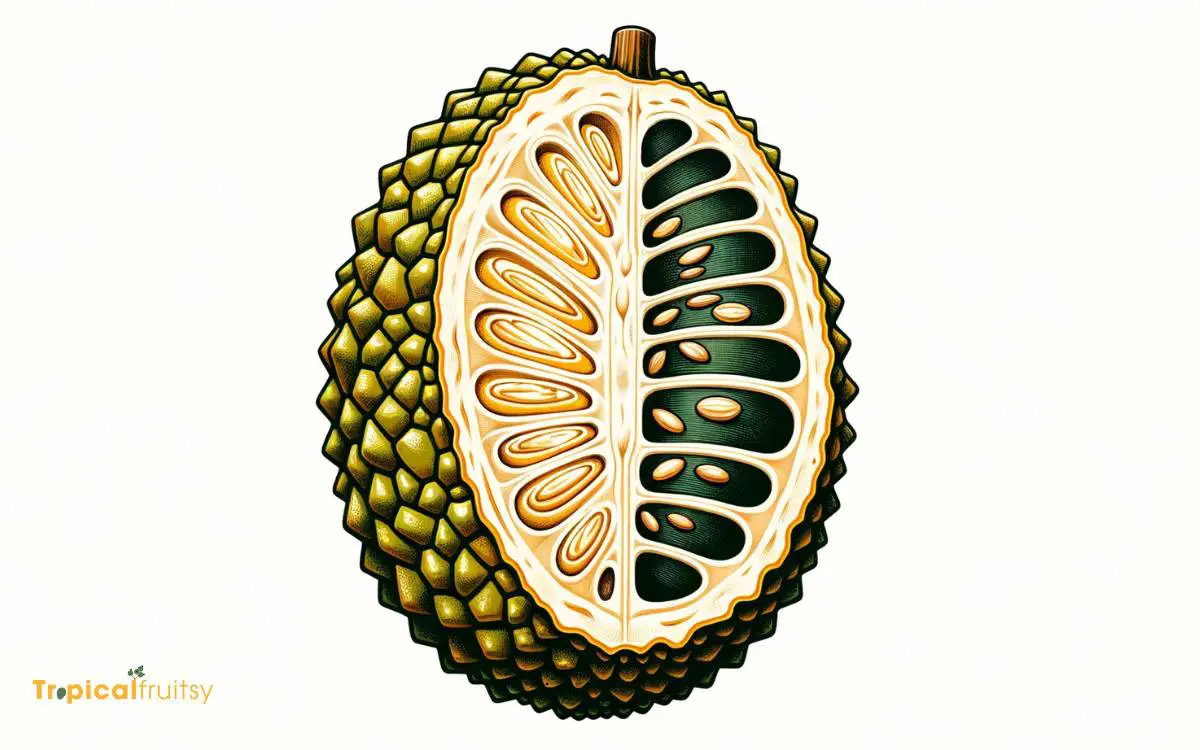
Upon dissection, the internal composition of breadfruit reveals a starchy, creamy flesh. The texture of the flesh can vary significantly depending on the degree of ripeness.
The presence of seeds within the fruit is largely dependent on the specific cultivar. Seedless varieties have been cultivated for ease of consumption and processing.
Detailed analysis of the flesh’s texture and seed distribution is essential for understanding the fruit’s culinary applications and breeding improvements.
Flesh Texture
Commonly, the inner flesh of breadfruit exhibits a creamy, starchy texture, akin to that of a freshly baked potato.
This particular consistency is the result of the breadfruit’s cellular structure and its high starch content, which changes with ripeness.
- High Starch Content: The flesh contains amylopectin and amylose, contributing to its dense, starchy nature.
- Cellular Structure: Composed of a spongy parenchyma that retains moisture, leading to a smooth texture.
- Ripening Process: As it ripens, the texture softens further and becomes sweeter, much like a ripe banana.
- Cooking Transformations: Heat alters the starches, making the flesh fluffier and more bread-like.
- Culinary Uses: Ideal for mashing, roasting, or frying due to its versatile texture.
Understanding the flesh’s texture provides insight into the breadfruit’s culinary potential and hints at the presence of seeds within certain cultivars, which we will explore next.
Seed Presence
While some varieties of breadfruit are seedless, others contain seeds that are round, shiny, and edible when cooked.
The presence of seeds in breadfruit is a trait that varies depending on the species and individual cultivar. Seeded breadfruit varieties produce seeds that are encased within the fleshy part of the fruit.
These seeds typically measure approximately 1 to 2 centimeters in diameter and possess a hard outer coating that becomes suitable for consumption upon proper thermal processing.
Scientific analysis reveals that the seeds are rich in starch and protein, making them a nutritious supplement to the diet.
The morphology of breadfruit seeds, including size and number, can be critical phenotypic indicators of the genetic diversity within Artocarpus altilis species.
Understanding such variations in seed characteristics among breadfruit varieties provides a segue into examining the broader topic of ‘varieties and their differences’.
Varieties and Their Differences
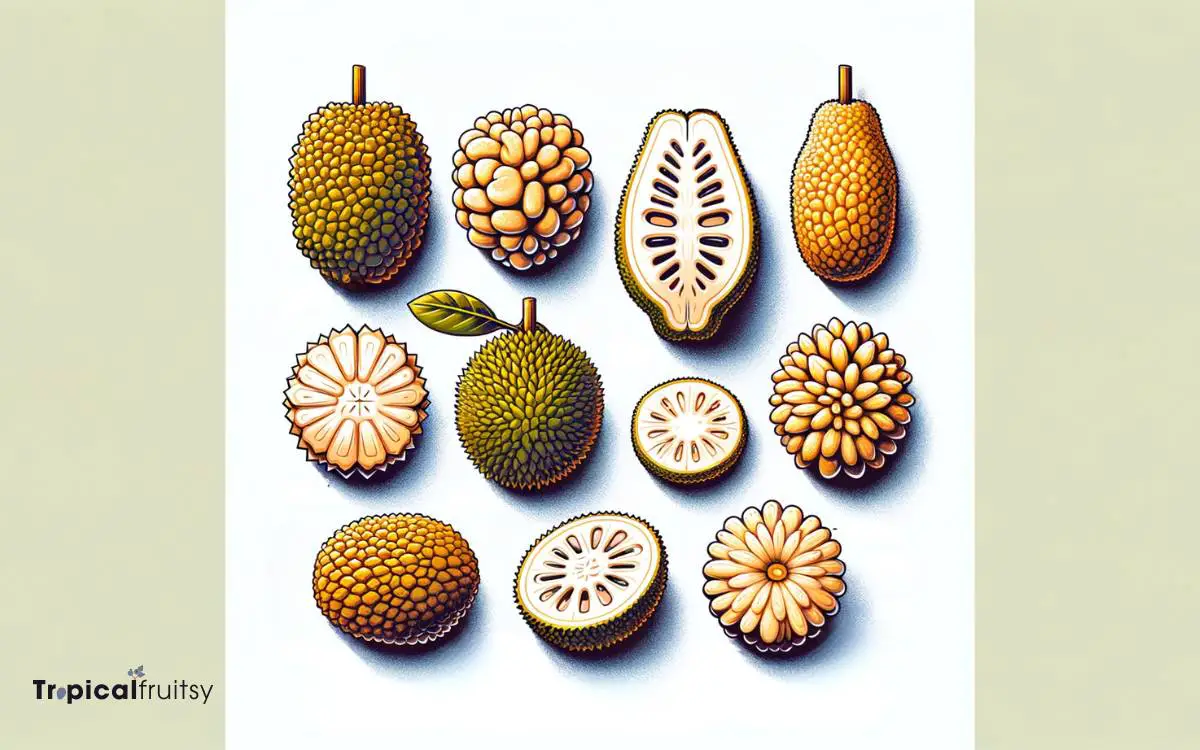
Breadfruit’s various cultivars exhibit a range of physical characteristics, from the size and shape of the fruit to the texture and color of its skin.
Scientific classification has identified numerous varieties, each with unique attributes that distinguish them from one another.
Here are some key variations:
- Size: Some cultivars produce small, compact fruits, while others grow large, with diameters exceeding 30 centimeters.
- Shape: The morphology ranges from spherical to oblong, with variable degrees of surface irregularities.
- Texture: Skin texture can be smooth, scaly, or spiky, affecting the fruit’s handling and processing.
- Color: There is a spectrum from green to yellowish-brown, signaling different ripening stages and sugar content.
- Taste and Flesh: The flavor profiles vary, with some being sweet and creamy, while others are more starchy or fibrous.
Knowledge of these differences is crucial for cultivation, culinary applications, and nutritional analysis.
Is the Appearance of Breadfruit Related to its Origin and History?
The appearance of breadfruit is indeed related to its origins and history. The unique texture and shape of breadfruit have been uncovered to be a result of its evolution in the Pacific Islands. The ancient cultivation and consumption of this fruit have shaped its appearance over time.
Breadfruit is a Fruit or Vegetable

Breadfruit is a fruit. It is a tropical tree fruit that belongs to the Moraceae family and is closely related to other fruits like jackfruit and figs.
Breadfruit is known for its starchy, bread-like texture when cooked, which is how it got its name. It is commonly used as a staple food in many tropical regions and can be prepared in various ways, including frying, boiling, roasting, or baking.
Despite its starchy characteristics, breadfruit is botanically classified as a fruit because it develops from the ovaries of the breadfruit tree’s flowers and contains seeds, although the seeds are typically not consumed.
Conclusion
The breadfruit stands as an emblem of tropical abundance. Its morphological diversity serves as a testament to nature’s ingenuity.
The breadfruit’s size, akin to a celestial body in the arboreal heavens, and its complex tapestry of botanical artistry in its skin are harbingers of the rich, starchy treasures that lie within.
Moreover, as it ripens, the breadfruit undergoes a chromatic transformation, revealing the evolutionary craftsmanship at play in its internal architecture.
The aesthetic and culinary versatility of the breadfruit underscore its unparalleled significance within the pantheon of tropical flora.

